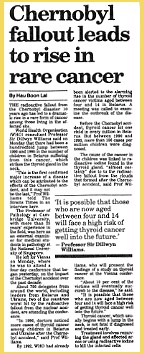
 THE radioactive fallout from the Chernobyl disaster 10 years ago has led to a dramatic rise in a rare form of cancer among those living in the affected site.
THE radioactive fallout from the Chernobyl disaster 10 years ago has led to a dramatic rise in a rare form of cancer among those living in the affected site.
 World Health Organization (WHO) consultant Professor Sir Dillwyn Williams said on Monday that there had been a hundredfold jump between 1990 and 1995 in the number of children in Belarus suffering from this cancer, which strikes the thyroid gland in the neck.
World Health Organization (WHO) consultant Professor Sir Dillwyn Williams said on Monday that there had been a hundredfold jump between 1990 and 1995 in the number of children in Belarus suffering from this cancer, which strikes the thyroid gland in the neck.
 "This is the first confirmed major increase of a disease which can be attributed to the effects of the Chernobyl accident, and it may not be the last," Prof Williams told The Straits Times in an interview here.
"This is the first confirmed major increase of a disease which can be attributed to the effects of the Chernobyl accident, and it may not be the last," Prof Williams told The Straits Times in an interview here.
 The Professor of Pathology at Cambridge University, with more than 25 years' experience in the field, was here as an external examiner for medical students in pathology at the National University of Singapore.
The Professor of Pathology at Cambridge University, with more than 25 years' experience in the field, was here as an external examiner for medical students in pathology at the National University of Singapore.
 He left for Vienna on Monday, where he was to attend a four-day conference that began yesterday, on the impact of the Chernobyl accident over the past decade.
He left for Vienna on Monday, where he was to attend a four-day conference that began yesterday, on the impact of the Chernobyl accident over the past decade.
 About 700 delegates from around the world, including leaders from Belarus and Ukraine, two of the countries worst hit by the radioactive fallout from the nuclear accident, are attending the conference.
About 700 delegates from around the world, including leaders from Belarus and Ukraine, two of the countries worst hit by the radioactive fallout from the nuclear accident, are attending the conference.
 "In 1990, doctors noticed more cases of thyroid cancer among children in Belarus and Ukraine after the Chernobyl accident," said Prof Williams.
"In 1990, doctors noticed more cases of thyroid cancer among children in Belarus and Ukraine after the Chernobyl accident," said Prof Williams.
 By 1992, WHO had already been alerted to the alarming rise in the number of thyroid cancer victims aged between four and 14 in Belarus. A meeting was called to examine the outbreak of the disease.
By 1992, WHO had already been alerted to the alarming rise in the number of thyroid cancer victims aged between four and 14 in Belarus. A meeting was called to examine the outbreak of the disease.
 Before the Chernobyl accident, thyroid cancer hit one child in every million in Belarus. But between 1990 and 1995, more than 100 cases per million children were diagnosed.
Before the Chernobyl accident, thyroid cancer hit one child in every million in Belarus. But between 1990 and 1995, more than 100 cases per million children were diagnosed.
 The cause of the cancer in the children was linked to radioactive iodine found in the thyroid gland, "almost certainly" due to to the radioactive fallout from the clouds that formed after the Chernobyl accident, said Prof Williams, who will present the findings of a study on thyroid cancer at the Vienna conference.
The cause of the cancer in the children was linked to radioactive iodine found in the thyroid gland, "almost certainly" due to to the radioactive fallout from the clouds that formed after the Chernobyl accident, said Prof Williams, who will present the findings of a study on thyroid cancer at the Vienna conference.
 "About 10 per cent of the victims will eventually succumb to the disease," he said.
"About 10 per cent of the victims will eventually succumb to the disease," he said.
 "It is possible that those who are now aged between four and 14 will face a high risk of getting thyroid cancer well into the future."
"It is possible that those who are now aged between four and 14 will face a high risk of getting thyroid cancer well into the future."
 Thyroid cancer, which usually begins with a lump in the neck, is not fatal if diagnosed and treated early.
Thyroid cancer, which usually begins with a lump in the neck, is not fatal if diagnosed and treated early.
 Treatment involves removing the gland and affected areas or using radioactive iodine to kill the infected cells.
Treatment involves removing the gland and affected areas or using radioactive iodine to kill the infected cells.